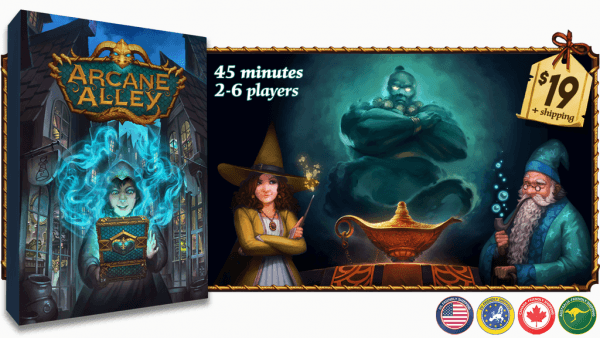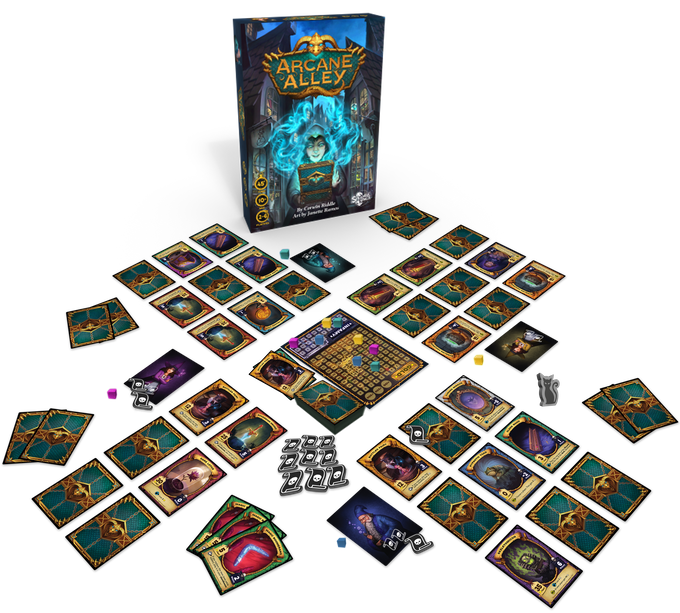Interview: Arcane Alley and the Riddle of Marketing a Kickstarter Campaign

Corwin Riddle is as intriguing and captivating as his name implies. Corwin has recently launched his first Kickstarter campaign through his company, Strange Space Games, for Arcane Alley. The Kickstarter looks phenomenal and is nearly fully funded (at the time of writing). Plus, Corwin is a writer like myself, so I knew I had to talk with him. Without further ado, here is my interview.
Andrew Birkett: Hey Corwin, I am really excited for Arcane Alley. It looks like a really fun game! What led you to design games? Is Arcane Alley the first game you've designed?
Corwin Riddle: Thanks, Andrew! It’s been a long (sometimes bumpy) road but I think it has turned out well! It’s easy enough for casual gamers to learn, but deep enough to keep experienced gamers from getting bored—that was the goal, really, to unite two different groups of gamers with something everyone can enjoy.
I think that running a D&D game was the start. As a DM, you’re encouraged to make up your own scenarios, themes, and even rules. It seemed natural to start looking at every game through that lens. I was constantly trying to figure out why something in a game did or didn’t work or feel fun. After a while, I felt like I had a good grasp of system design, and a willing group of participants with the D&D group to help refine designs by playing them again and again with small tweaks.
Arcane Alley is the second game I’ve designed, but the first one was a complicated, heavy, and expensive game to make and ship. I wanted my first Kickstarter to be a relatively small game with few parts because I thought I’d make a lot of amateur mistakes (I did) and didn’t want to get overwhelmed (I still did). I plan to launch the heavy game on Kickstarter next year, I’ve been working on it for almost 4 years now and it’s definitely the favorite child.
AB: I see that you're a writer, like myself. Do you feel that being a writer has helped you with designing Arcane Alley?
CR: I think so! A lot, actually, maybe not with the initial design, but absolutely when it comes to refining it. Writing is all about revision and figuring out how to make something work and fit smoothly—a thought, a quote, a plot point—and I think that has the same foundation as game design.
Most importantly, I think being a writer trained me to take criticism without getting discouraged. I had a hard time with this at first, but a few dozen workshops of people just tearing my work to shreds, I really did get used to it, to listening to the audience without trying to defend the work or justify a decision. And that’s what matters, right? I mean, this is for the audience, in the end. It doesn’t matter what my intention was; if it’s not coming across, I need to find out why, and how to fix it.
AB: Did you start working with the theme in mind or did you start with game mechanisms?
CR: I had some basic mechanisms down first. I had been playing a lot of 9-card golf with some friends, but it just wasn’t quite engaging enough—cards were simply good or bad, not much decision making. But I liked the idea of the personal area, of clearing rows, of not wanting things left in your area, and went from there.
I had a few different ideas on the theme, most were some kind of illicit market, which made the most sense to me: a reason for getting rid of stuff (selling), a reason not to have stuff left (getting caught), and I just needed a reason for everything in the game to have some kind of effect. Well, why not magic? Magic can do anything! So wizard market it was.

AB: What do you feel is the most unique element of the gameplay for Arcane Alley?
CR: I think the inspection mechanic is unique, and how players utilize it almost always determines the outcome of the game. It’s this looming, inevitable timebomb that any player can activate shortly into a round, and everyone always has to be ready for it to go off. It’s not necessarily important that you make a bunch of sets if you can trigger the inspection and catch other players with a lot of infamy. Them losing gold from fines is second-best to you gaining gold yourself.
And you really need to be paying attention to what all of the other players are doing. Is someone overextending? Is someone only going to sell more, if the round continues for a few more turns? Players that recognize that perfect moment, when to call the inspection to help themselves and punish other players, can always come back and win.
Also, this isn’t a unique gameplay element, but I tried to make sure every item in the game has its behavior tied to its theme. The boomerang keeps coming back if you try to get rid of it. The invisible ring disappears if you discard it. The mirror reflects nearby items. The haunted doll never goes away. I wanted players to look at an item, look at what it does, and think it made sense.
AB: Why did you decide to self-publish instead of working with an existing publisher?
CR: If there hadn’t already been a lot of good examples and advice from successful Kickstarter designers like James Mathe and Jamey Stegmaier, I probably would have looked for an existing publisher, and I did consider doing that for a long time.
Eventually, I realized that there was so much information out there, so much advice, that the intimidating parts of the process were being demystified, one by one. Shipping? Here’s a guide. Taxes? Here’s a guide. Setting up for manufacturing? Here’s a list of parts and prices.
These other guys (bless them) blazed the trail, made all the first mistakes, and then graciously warned us about them. They basically wrote step-by-step instructions for the rest of us, and all of a sudden self-publishing seemed doable.
That being said, I’m still not 100% sure I made the right decision. It’s been a lot of time spent, stress, and more logistics than I was prepared for, and I often wonder if I would have been better-served pitching games instead of trying to do it myself. I still don’t know. Is this a non-answer? This might be a non-answer.
AB: Looking at your Kickstarter profile I see you've backed 78 projects, including one of mine (thank you!). How important do you think supporting other projects on Kickstarter is for a first-time creator?
CR: Yeah, Mutant Crops! Who doesn’t love a zombie eggplant?
I think it’s pretty important to back other projects, not only to show support for the community that I’m now asking to support me, but for the sheer amount of knowledge to be gained from it.
When I back, I get to see every facet of these campaigns and I have had so many great examples of what to do (or not do) when I finally launched. I had probably 25-30 campaigns saved with notes on a specific thing they did or said, a graphic layout I liked, or something I wanted to avoid. When I started making my own Kickstarter campaign, I already knew how I wanted to handle a lot of the presentation, process, and communication.
AB: What was the most important thing you've done to prepare for your first Kickstarter campaign?
CR: I’m going to give two answers here because I want to be a special and unique snowflake and every new creator gives this same first answer.
But also, it’s correct.
I read the blogs! I bookmarked every Stegmaier and Mathe post that gave explicit instructions for what to do and when to do it. This article by James Mathe, for example, is the single most helpful blog post I’ve ever read in my life. It even has a literal checklist to download and track every step of a campaign. Every uncertainty I had, for taxes, fulfillment, packing, types of cardstock, anything, there was a blog post on it.
The second answer would be making the Kickstarter page itself look as professional as possible. Most people will lazily scroll down your page for a few seconds before they decide to keep going or bail. GIF didn’t load fast enough? Gone. Link didn’t work? Gone. Can’t find the component list? Gone. I didn’t want anyone to leave because a graphic looked bad, or they couldn’t tell what was going on, or couldn’t understand shipping, or (most importantly) couldn’t tell how the game played.
Basically, I knew that not everyone would be interested in the game itself, and that’s fair, but I wanted that to be the only thing that would drive someone away from the page.
AB: This is not really a question, but Arcane Alley is absolutely gorgeous! How did you find the artist, Janette Ramos, who worked on the campaign?
CR: I had a general idea of the art style I wanted, so I went on Deviantart and almost immediately found Janette’s page, and was blown away. Her profile mentioned that she was open for commissions, so I emailed her and asked her if she wanted to make a board game. I was surprised when she said yes since I had nothing I could use to show her I knew what I was doing (because I didn’t, but don’t tell her that), but it worked out!
Besides being an amazing artist, she was also a dream to work with, and so patient with me as I stumbled around figuring out what I needed and how to work with the files.
AB: The animated images on your campaign, which show how to play the game do an incredible job of showcasing the mechanisms. Did you always know you would use GIFs to showcase the gameplay or did potential backers request those?
CR: I looked into these after a few times of struggling to explain the game to people without a visual aid. The game itself is easy to pick up, there’s a lot going on but not a lot you can do on any one turn, so there’s plenty of time to figure out what’s happening.
Explaining the game in words makes it sound so overwhelming—you have 9 cards, then get 2 more, then flip any 2, no not those 2, 2 of the 9, and then draw another, then play one of these 2, now 3, and there are 4 different effects…and I could just see eyes glazing over, even though I knew they’d completely understand it in a minute once it was on the table, so I knew I had to have a visual aid before the campaign went live.
I went to Ferdinand at The Cardboard Stacker for some professional ones (he also made the video). At playtests, I just show them to people and it’s helped speed things up a lot.

AB: When did you start working on Arcane Alley? How long did it take to prepare the Kickstarter, including producing the art assets, campaign graphics and get reviewers to preview the game?
CR: I started on this game about 18 months ago and had all of the actual game art finished this May, then sent away for the prototype copies and started contacting reviewers around July. I started on the campaign graphics in August and worked on those almost right up to the campaign, I think I was still changing the “what you get” graphics the night before it went live.
If I could do it again I would have left myself more time for the graphics and video, that was down to the wire and took away a lot of important time close to launch that should have been spent marketing instead.
AB: What is the largest lesson you've learned from launching your first campaign?
CR: I should have built an audience beforehand by engaging with people. I didn’t and honestly, Arcane Alley should have fallen flat on its magical face. If it wasn’t for some great reviewer responses to the game (and Janette’s art, specifically) and a lot of support from what engagement I had, I would have absolutely failed for no other reason than I’m shy and don’t like to bother people, and that’s the worst reason ever to fail at something you’ve worked on for two years.
(I touch on this below in the marketing question).
AB: The campaign has already raised over $13,000. What do you attribute most to your success so far?
CR: I would love to say it’s all the hard work we put into Arcane Alley, but I know it’s because of how supportive my friends, family, and the board game community have all been. I was simply blown away—people were backing immediately, for multiple copies, and telling everyone they knew, and they seemed genuinely excited to do so. It had somehow reached 50% by the second day, despite my pitiful marketing efforts which should have doomed it from the start.
Second to that, I’d say presentation and polish. We tried so hard to make everything look and feel complete—the art, the graphic design, the gameplay, the rules, presentation—when the Kickstarter launched, we didn’t want anyone to feel like they were seeing an unfinished product. We felt we had a great game and wanted people to see the quality of it right away.
AB: What marketing efforts did you utilize for the campaign and how early did you start promoting the game?
CR: I started posting things on Facebook and Instagram about 2 months before the game launched, and that’s…about it. My email list was (and I’m not kidding here) three people, not including friends and family. I hoped that having reviewers posting videos of the game would send their channel audiences my way, and relied on that plus some FB ads being enough.
It was, but it shouldn’t have been and had I done a better job at marketing, I know the game would be doing a lot better than it is now. This was my biggest mistake and I every single day I kick myself for not making it a priority over the last year to engage with people more or stay connected. It’s so important, and whenever it came up, I just seemed to shrug and tell myself I’d do it later. For example, I would run a playtest for my game, with a bunch of strangers who enjoyed it and then forget to get their emails, with no way to contact them ever again—I was that bad at this.
And online, I’ve been a part of these communities for years, Facebook groups, on BoardGameGeek and Reddit, but I was doing more lurking than talking to people. It fully hit me on launch day when I realized I didn’t feel comfortable going to these places and telling them about my game—I had been around, but they didn’t know me.
I was so focused on having a great looking and great playing game that I spent all of my time refining the look and tweaking mechanics and playtesting when I should have been going working to build an audience through real, authentic engagement.
Ironically, now that I’ve launched, I’ve met and have been talking to a ton of creators and backers about this whole process, so I guess I got there in the end, but a smarter person would have done this from the beginning.

AB: What is your favorite card in Arcane Alley and why?
CR: Visually, I love the Facsimilous Feline—the Cheshire cat, mimic, disguised as a chest to lure in an unsuspecting mouse. It’s beautiful and I love it so much that I ordered a giant print of it to hang in my house.
Mechanically, I like the Magical Boomerang. If you know where a hidden one lies in your storehouse, you can chain together some amazing plays in a turn where you’re constantly bouncing them back to reveal several items in one turn, and in some cases can trigger the inspection that turn when they thought they had more time. If another player has 2 boomerangs showing for a while, I promise you, they’re up to something!
AB: You have provided some great insights. Thank you for taking the time to participate in this interview!
CR: Anytime, thanks for the opportunity!




